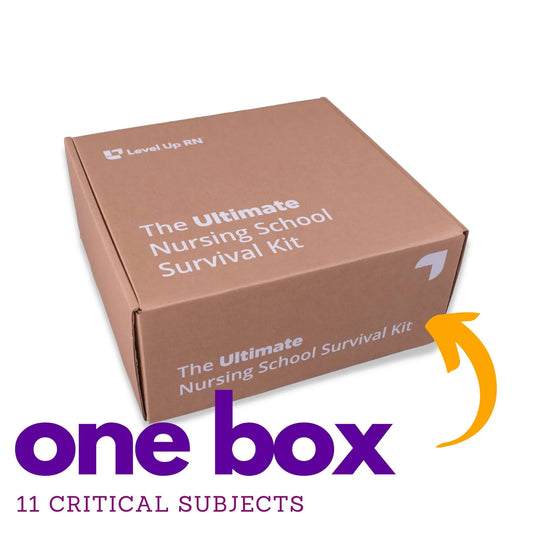Nursing Tips
Medical-Surgical (116)

Thyrotoxicosis
Thyrotoxicosis (thyroid storm) is a medical emergency for a patient with hyperthyroidism. Administer beta blockers and anti-thyroid medications as ordered. Prepare patient for a thyroidectomy if indicated.
Thyrotoxicosis
Thyrotoxicosis (thyroid storm) is a medical emergency for a patient with hyperthyroidism. Administer beta blockers and anti-thyroid medications as ordered. Prepare patient for a thyroidectomy if indicated.

Tricuspid Valve
The Tricuspid valve separates the right atrium from the right ventricle of the heart.
Tricuspid Valve
The Tricuspid valve separates the right atrium from the right ventricle of the heart.

Occipital Lobe versus Temporal Lobe
The occipital lobe of the brain contains the visual cortex, while the temporal lobe contains the auditory cortex.
Occipital Lobe versus Temporal Lobe
The occipital lobe of the brain contains the visual cortex, while the temporal lobe contains the auditory cortex.
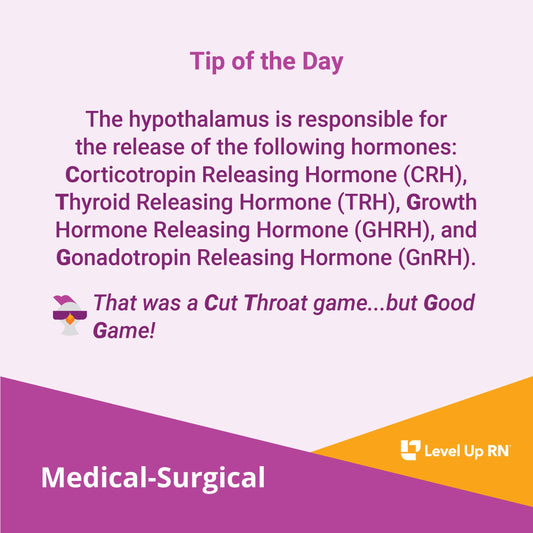
Hypothalamus
The hypothalamus is responsible for the release of the following hormones: Corticotropin Releasing Hormone (CRH), Thyroid Releasing Hormone (TRH), Growth Hormone Releasing Hormone (GHRH), and Gonadotropin Releasing Hormone (GnRH).
Hypothalamus
The hypothalamus is responsible for the release of the following hormones: Corticotropin Releasing Hormone (CRH), Thyroid Releasing Hormone (TRH), Growth Hormone Releasing Hormone (GHRH), and Gonadotropin Releasing Hormone (GnRH).
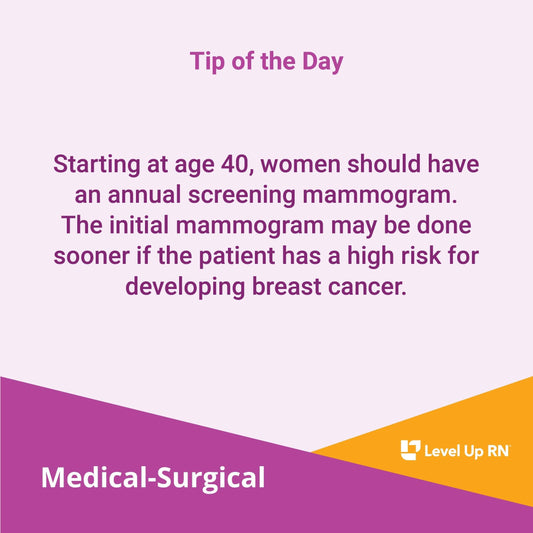
Mammogram Screening
Starting at age 40, women should have an annual screening mammogram. The initial mammogram may be done sooner if the patient has a high risk for developing breast cancer.
Mammogram Screening
Starting at age 40, women should have an annual screening mammogram. The initial mammogram may be done sooner if the patient has a high risk for developing breast cancer.
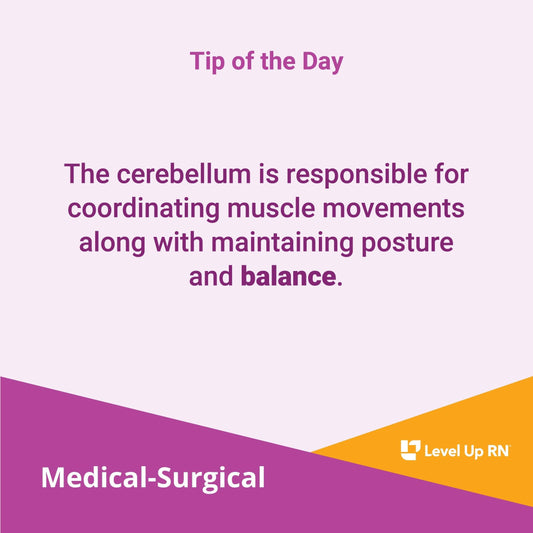
The Cerebellum
The cerebellum is responsible for coordinating muscle movements along with maintaining posture and balance.
The Cerebellum
The cerebellum is responsible for coordinating muscle movements along with maintaining posture and balance.
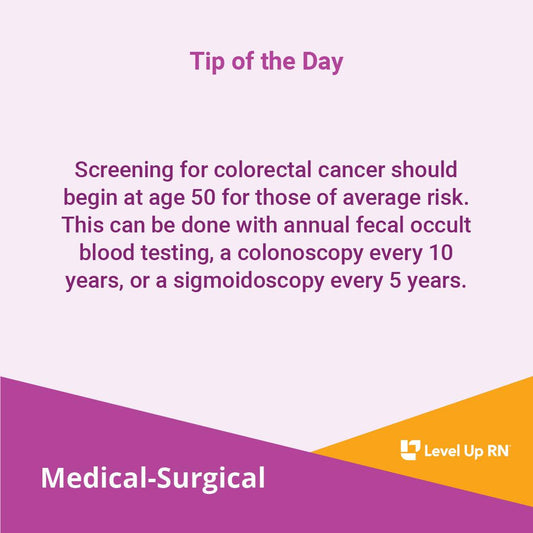
Screening for Colorectal Cancer
Screening for colorectal cancer should begin at age 50 for those of average risk.
Screening for Colorectal Cancer
Screening for colorectal cancer should begin at age 50 for those of average risk.
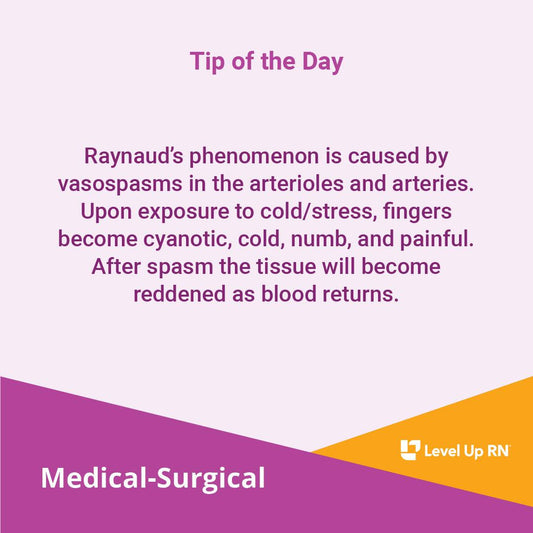
Raynaud's phenomenon
Raynaud's phenomenon is caused by vasospasms in the arterioles and arteries. Upon exposure to cold/stress, fingers become cyanotic, cold, numb, and painful. After spasm the tissue will become reddened as...
Raynaud's phenomenon
Raynaud's phenomenon is caused by vasospasms in the arterioles and arteries. Upon exposure to cold/stress, fingers become cyanotic, cold, numb, and painful. After spasm the tissue will become reddened as...

Hemolysis
If an Rh-negative person receives Rh-positive blood, it will cause hemolysis—destruction of RBCs (red blood cells)!
Hemolysis
If an Rh-negative person receives Rh-positive blood, it will cause hemolysis—destruction of RBCs (red blood cells)!
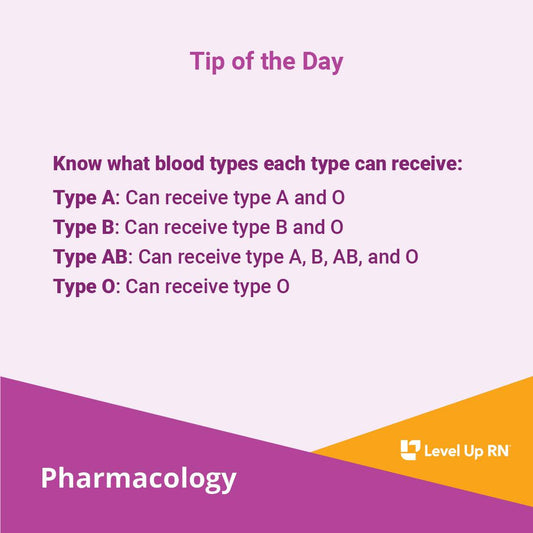
What blood type can receive what blood type?
Know what types each blood type can receive: Type O: Can receive O Type A: Can receive A and O Type B: Can receive B and O Type AB: Can receive A, B,...
What blood type can receive what blood type?
Know what types each blood type can receive: Type O: Can receive O Type A: Can receive A and O Type B: Can receive B and O Type AB: Can receive A, B,...

Glomerulonephritis Labs
Key labs with Glomerulonephritis: Serum: Positive antistreptolysin-O titer. Urinanalysis: hematuria, proteinuria. Throat culture: Positive for group A beta-hemolytic streptococcus
Glomerulonephritis Labs
Key labs with Glomerulonephritis: Serum: Positive antistreptolysin-O titer. Urinanalysis: hematuria, proteinuria. Throat culture: Positive for group A beta-hemolytic streptococcus

Urinary Tract Infection
With a Urinary Tract Infection (UTI), the urinanalysis may be positive for leukocyte esterase and nitrites.
Urinary Tract Infection
With a Urinary Tract Infection (UTI), the urinanalysis may be positive for leukocyte esterase and nitrites.
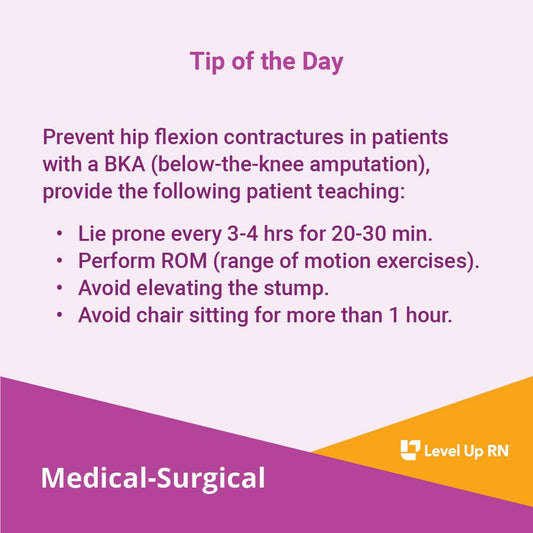
Hip Flexion Contractures
Prevent hip flexion contractures in patients with a BKA (below-the-knee amputation): Have patient lie prone every 3-4 hrs for 20-30 min.
Hip Flexion Contractures
Prevent hip flexion contractures in patients with a BKA (below-the-knee amputation): Have patient lie prone every 3-4 hrs for 20-30 min.

Mucositis (related to chemotherapy)
For patients who suffer mucositis (related to chemotherapy): Avoid glycerin or alcohol containing mouthwashes!!
Mucositis (related to chemotherapy)
For patients who suffer mucositis (related to chemotherapy): Avoid glycerin or alcohol containing mouthwashes!!

Diabetes HgbA1C Levels
For patients with Diabetes, the goal is to keep their HgbA1C under 7!
Diabetes HgbA1C Levels
For patients with Diabetes, the goal is to keep their HgbA1C under 7!
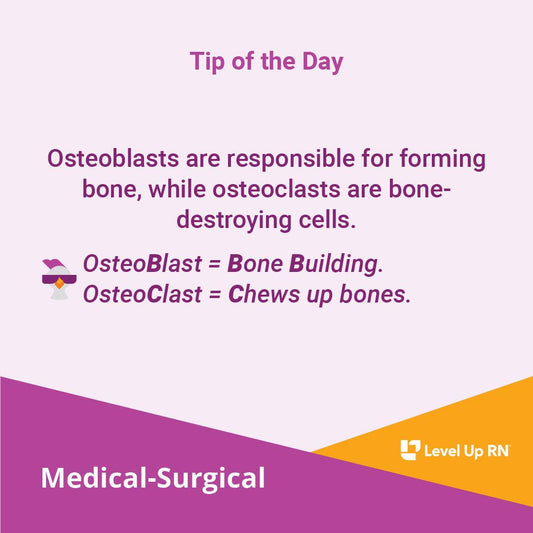
Osteoblasts versus Osteoclasts
Osteoblasts are responsible for forming bone, while osteoclasts are bone-destroying cells.
Osteoblasts versus Osteoclasts
Osteoblasts are responsible for forming bone, while osteoclasts are bone-destroying cells.
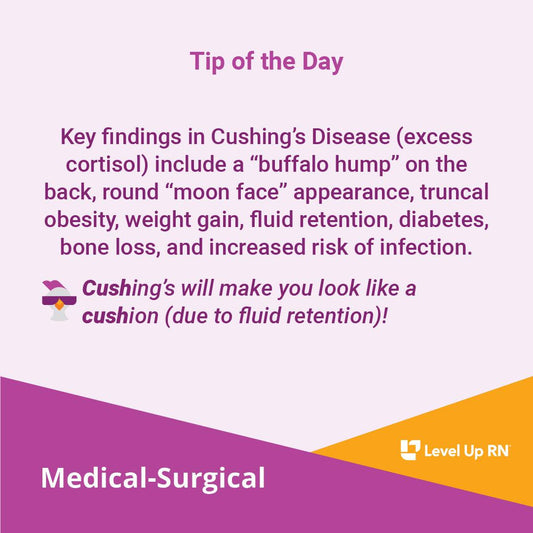
Cushing's Disease: Key Findings
Key findings in Cushing's Disease (excess cortisol) include a "buffalo hump" on the back, round "moon face" appearance, truncal obesity, weight gain, fluid retention, diabetes, bone loss, and increased risk...
Cushing's Disease: Key Findings
Key findings in Cushing's Disease (excess cortisol) include a "buffalo hump" on the back, round "moon face" appearance, truncal obesity, weight gain, fluid retention, diabetes, bone loss, and increased risk...

Rheumatoid Arthritis Symptoms
How to remember that Rheumatoid Arthritis causes swan neck and boutonniere deformities
Rheumatoid Arthritis Symptoms
How to remember that Rheumatoid Arthritis causes swan neck and boutonniere deformities
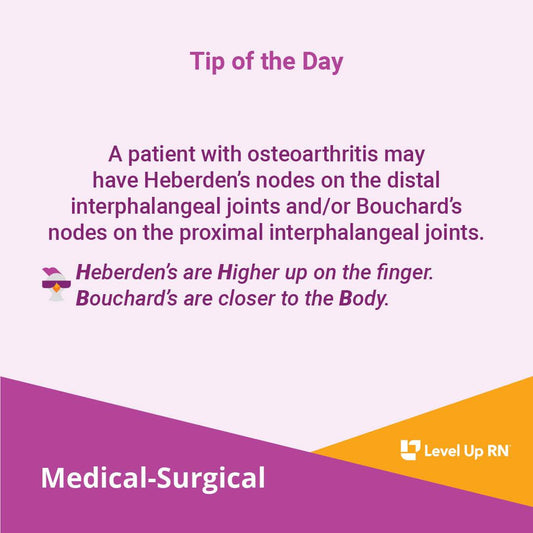
Osteoarthritis
A patient with osteoarthritis may have Heberden's nodes on the distal interphalangeal joints and/or Bouchard's nodes on the proximal interphalangeal joints.
Osteoarthritis
A patient with osteoarthritis may have Heberden's nodes on the distal interphalangeal joints and/or Bouchard's nodes on the proximal interphalangeal joints.
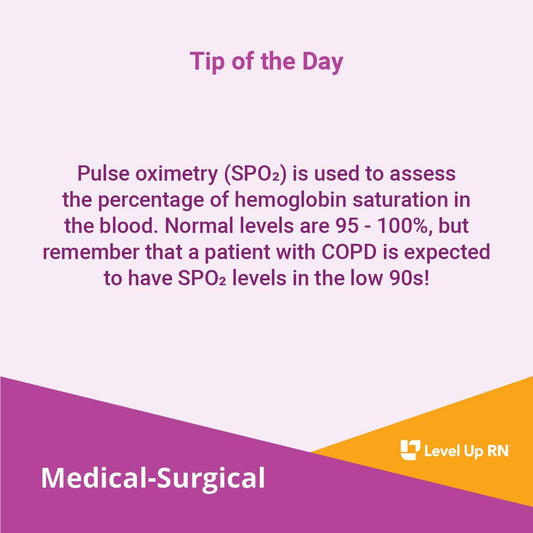
Pulse Oximetry (SPO2)
Pulse oximetry (SPO2) is used to assess the percentage of hemoglobin saturation in the blood. Normal levels are 95 - 100%, but remember that a patient with COPD is expected...
Pulse Oximetry (SPO2)
Pulse oximetry (SPO2) is used to assess the percentage of hemoglobin saturation in the blood. Normal levels are 95 - 100%, but remember that a patient with COPD is expected...
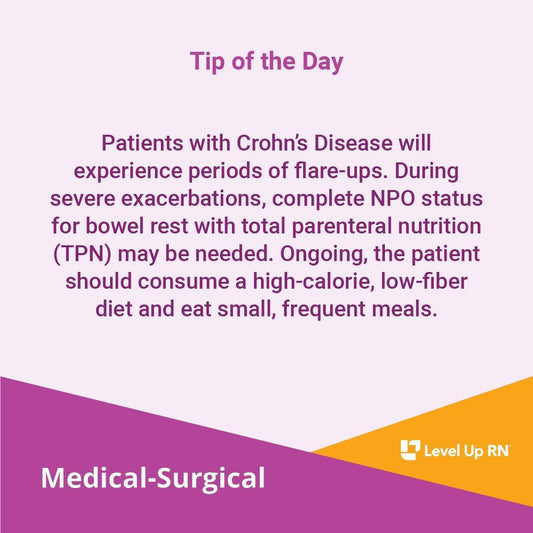
Crohn's Disease: Nursing Care
Patients with Crohn's Disease will experience periods of flare-ups. During severe exacerbations, complete NPO status for bowel rest with total parenteral nutrition (TPN) may be needed.
Crohn's Disease: Nursing Care
Patients with Crohn's Disease will experience periods of flare-ups. During severe exacerbations, complete NPO status for bowel rest with total parenteral nutrition (TPN) may be needed.
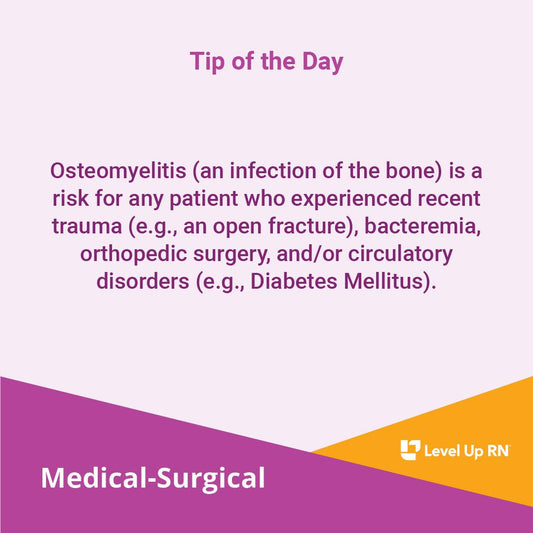
Osteomyelitis: Risk Factors
Osteomyelitis (an infection of the bone) is a risk for any patient who experienced recent trauma (e.g., an open fracture), bacteremia, orthopedic surgery, and/or circulatory disorders (e.g., Diabetes Mellitus).
Osteomyelitis: Risk Factors
Osteomyelitis (an infection of the bone) is a risk for any patient who experienced recent trauma (e.g., an open fracture), bacteremia, orthopedic surgery, and/or circulatory disorders (e.g., Diabetes Mellitus).
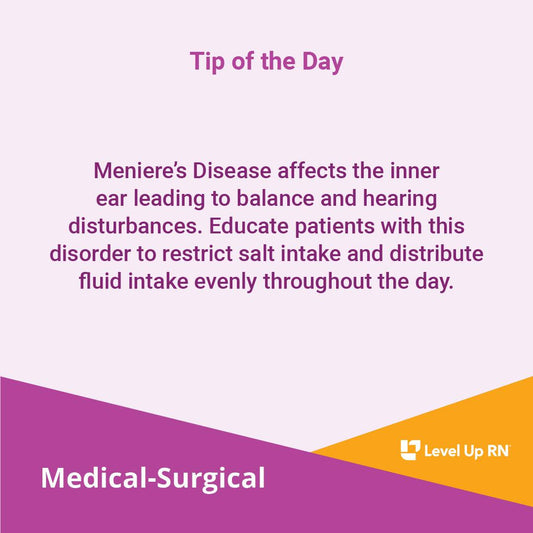
Meniere's Disease: Patient Teaching
Meniere's Disease affects the inner ear leading to balance and hearing disturbances.
Meniere's Disease: Patient Teaching
Meniere's Disease affects the inner ear leading to balance and hearing disturbances.
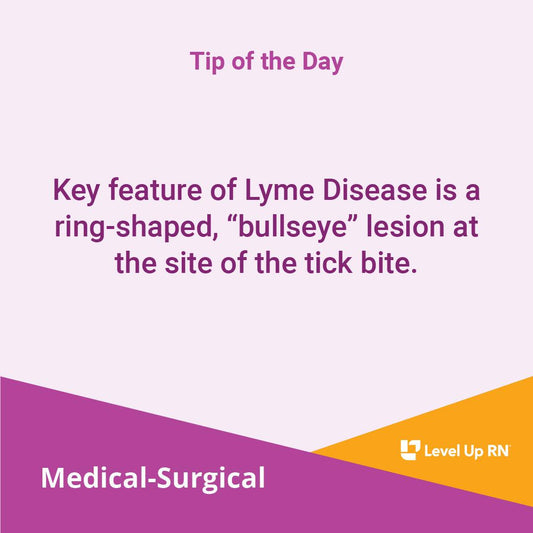
Lyme Disease
Key feature of Lyme Disease is a ring-shaped, "bullesye" lesion at the site of the tick bite.
Lyme Disease
Key feature of Lyme Disease is a ring-shaped, "bullesye" lesion at the site of the tick bite.
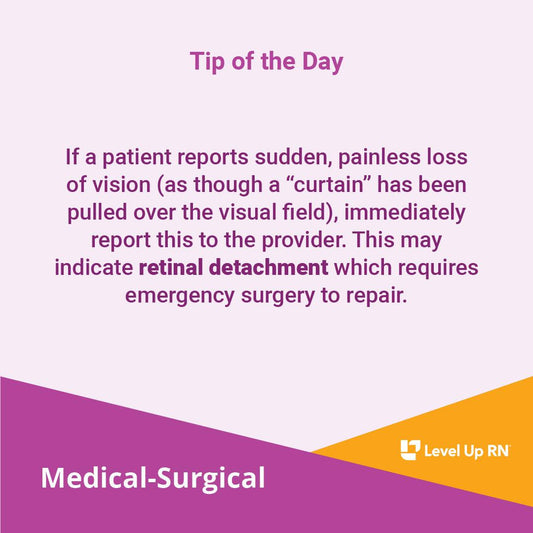
Retinal Detachment
If a patient reports sudden, painless loss of vision (as though a "curtain" has been pulled over the visual field), immediately report this to the provider. This may indicate retinal...
Retinal Detachment
If a patient reports sudden, painless loss of vision (as though a "curtain" has been pulled over the visual field), immediately report this to the provider. This may indicate retinal...
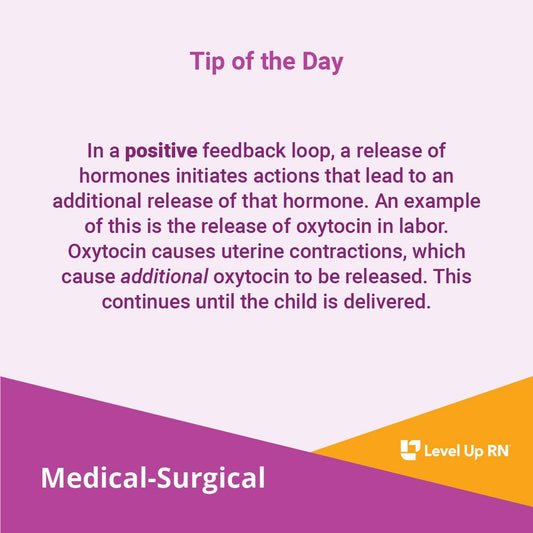
Positive Feedback Loop
In a positive feedback loop, a release of hormones initiates actions that lead to an additional release of that hormone.
Positive Feedback Loop
In a positive feedback loop, a release of hormones initiates actions that lead to an additional release of that hormone.

Halo Traction Devices
If a patient has a halo traction device in place, be sure wrench to release rods is attached to vest (so CPR can be performed in the event of an...
Halo Traction Devices
If a patient has a halo traction device in place, be sure wrench to release rods is attached to vest (so CPR can be performed in the event of an...
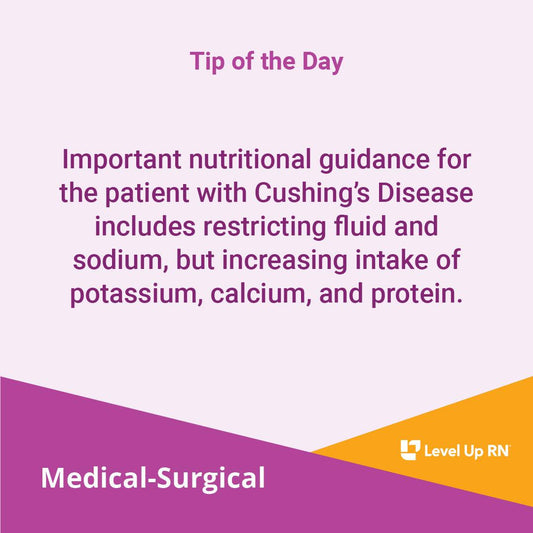
Cushing's Disease: Nutritional Guidance
Important nutritional guidance for the patient with Cushing's Disease includes restricting fluid and sodium, but increasing intake of potassium, calcium, and protein.
Cushing's Disease: Nutritional Guidance
Important nutritional guidance for the patient with Cushing's Disease includes restricting fluid and sodium, but increasing intake of potassium, calcium, and protein.
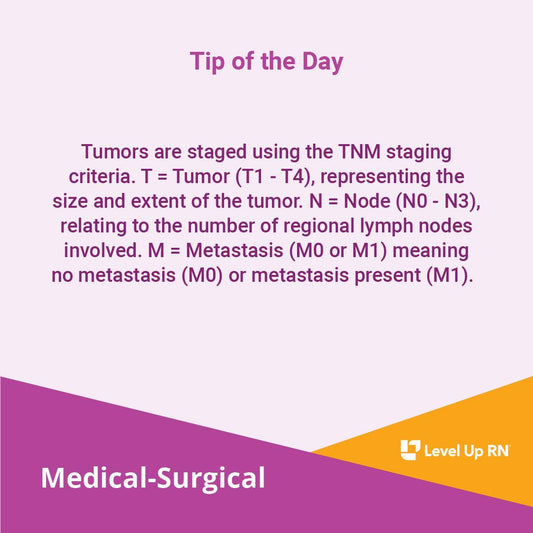
TNM Staging Criteria for Tumors
Tumors are staged using the TNM staging criteria. T = Tumor (T1 - T4), representing the size and extent of the tumor. N = Node (N0 - N3), relating to...
TNM Staging Criteria for Tumors
Tumors are staged using the TNM staging criteria. T = Tumor (T1 - T4), representing the size and extent of the tumor. N = Node (N0 - N3), relating to...
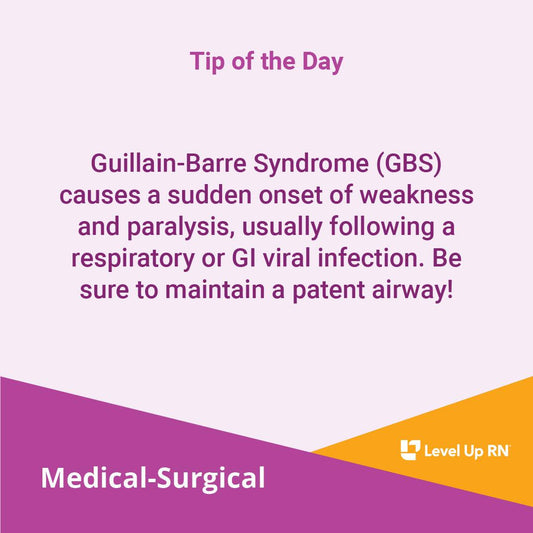
Guillain-Barre Syndrome (GBS)
Guillain-Barre Syndrome (GBS) causes a sudden onset of weakness and paralysis, usually following a respiratory or GI viral infection. Be sure to maintain a patent airway!
Guillain-Barre Syndrome (GBS)
Guillain-Barre Syndrome (GBS) causes a sudden onset of weakness and paralysis, usually following a respiratory or GI viral infection. Be sure to maintain a patent airway!
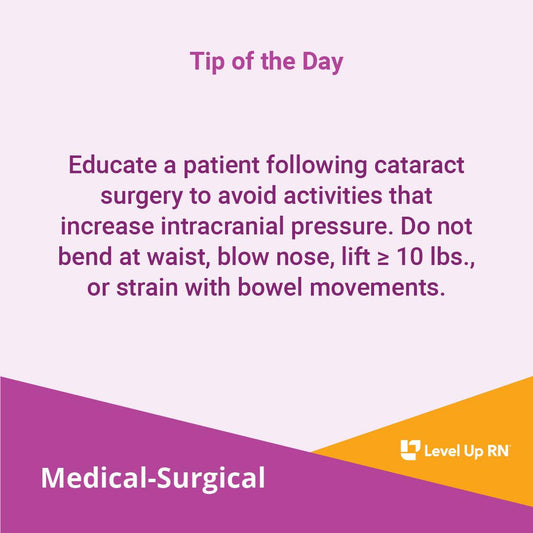
Cataract Surgery: Patient Teaching
Educate a patient following cataract surgery to avoid activities that increase intracranial pressure. Do not bend at waist, blow nose, lift ≥ 10 lbs., or strain with bowel movements.
Cataract Surgery: Patient Teaching
Educate a patient following cataract surgery to avoid activities that increase intracranial pressure. Do not bend at waist, blow nose, lift ≥ 10 lbs., or strain with bowel movements.
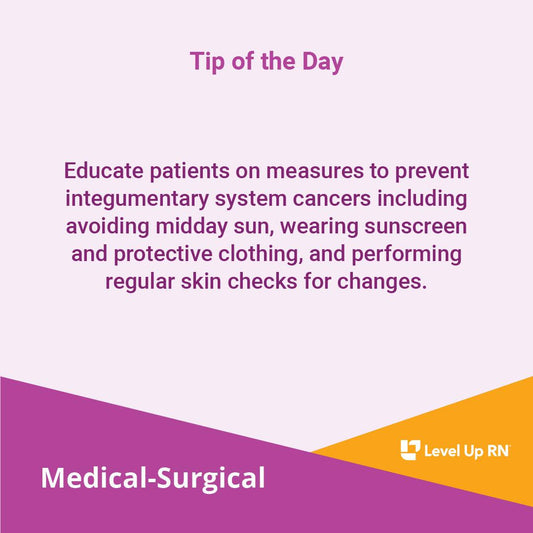
Skin Cancer
Educate patients on measures to prevent integumentary system cancers including avoiding midday sun, wearing sunscreen and protective clothing, and performing regular skin checks for changes.
Skin Cancer
Educate patients on measures to prevent integumentary system cancers including avoiding midday sun, wearing sunscreen and protective clothing, and performing regular skin checks for changes.

Gout: Patient Teaching
Educate patients who experience gout to avoid alcohol, purine-rich foods (e.g., red meat, organ meat, shellfish, high fructose drinks), and "starvation" dieting, but increase their fluid intake and reduce stress.
Gout: Patient Teaching
Educate patients who experience gout to avoid alcohol, purine-rich foods (e.g., red meat, organ meat, shellfish, high fructose drinks), and "starvation" dieting, but increase their fluid intake and reduce stress.

Rheumatoid Arthritis: Expected Labs
Expected labs with Rheumatoid Arthritis: Positive Rheumatoid Factor (RF) antibody and Positive ANA titer.
Rheumatoid Arthritis: Expected Labs
Expected labs with Rheumatoid Arthritis: Positive Rheumatoid Factor (RF) antibody and Positive ANA titer.
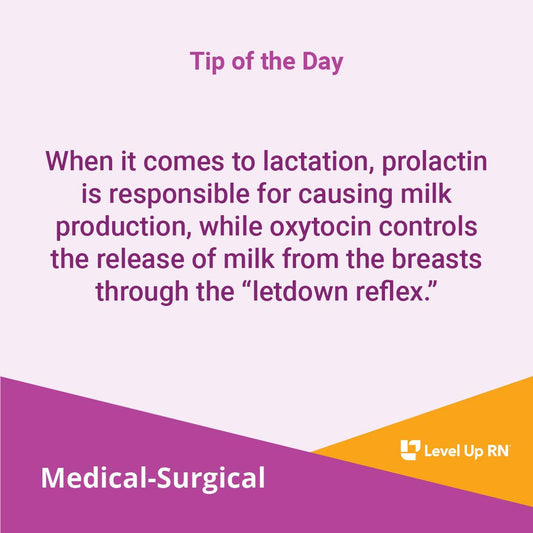
Lactation
When it comes to lactation, prolactin is responsible for causing milk production, while oxytocin controls the release of milk from the breasts through the "letdown reflex."
Lactation
When it comes to lactation, prolactin is responsible for causing milk production, while oxytocin controls the release of milk from the breasts through the "letdown reflex."
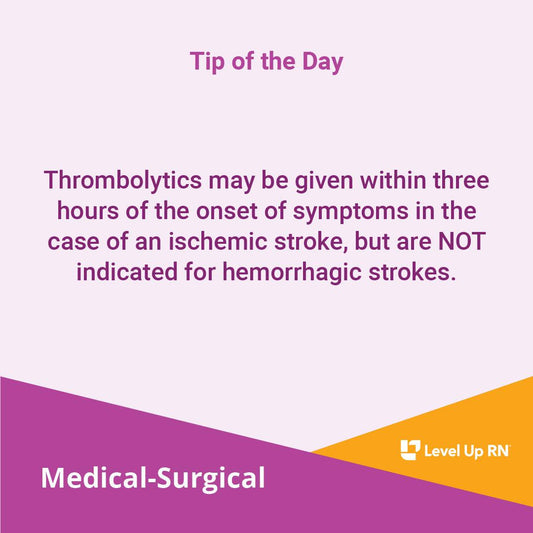
Thrombolytics
Thrombolytics may be given within three hours of the onset of symptoms in the case of an ischemic stroke, but are NOT indicated for hemorrhagic strokes.
Thrombolytics
Thrombolytics may be given within three hours of the onset of symptoms in the case of an ischemic stroke, but are NOT indicated for hemorrhagic strokes.
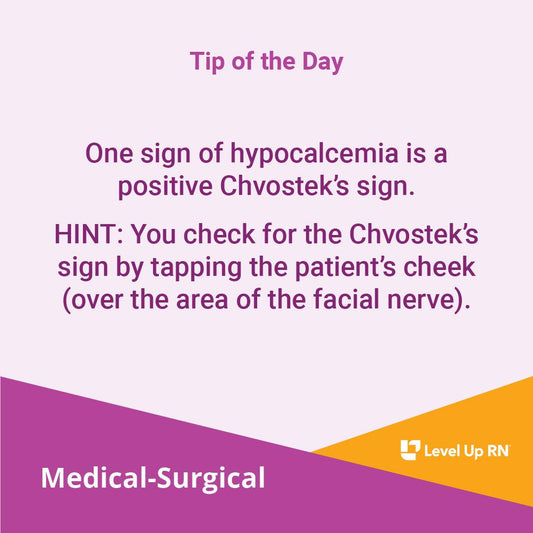
Chvostek's Sign
One sign of hypocalcemia is a positive Chvostek's sign. HINT: You check for the Chovostek's sign by tapping the patient's cheek (over the area of the facial nerve).
Chvostek's Sign
One sign of hypocalcemia is a positive Chvostek's sign. HINT: You check for the Chovostek's sign by tapping the patient's cheek (over the area of the facial nerve).

Hemodialysis: Nursing Care
Prior to initiating hemodialysis, auscultate their arteriovenous fistula for a bruit and palpate for a thrill.
Hemodialysis: Nursing Care
Prior to initiating hemodialysis, auscultate their arteriovenous fistula for a bruit and palpate for a thrill.
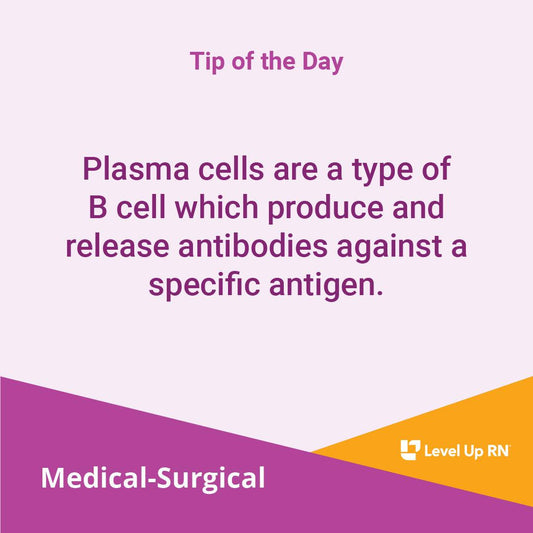
Plasma Cells
Plasma cells are a type of B cell which produce and release antibodies against a specific antigen.
Plasma Cells
Plasma cells are a type of B cell which produce and release antibodies against a specific antigen.
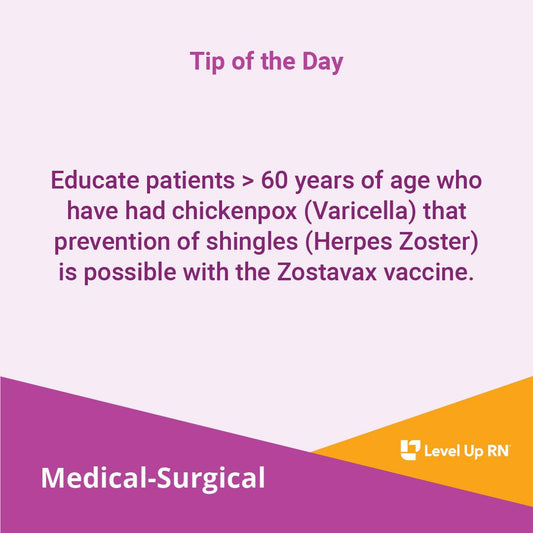
Zostavax Vaccine
Educate patients > 60 years of age who have had chickenpox (Varicella) that prevention of shingles (Herpes Zoster) is possible with the Zostavax vaccine.
Zostavax Vaccine
Educate patients > 60 years of age who have had chickenpox (Varicella) that prevention of shingles (Herpes Zoster) is possible with the Zostavax vaccine.
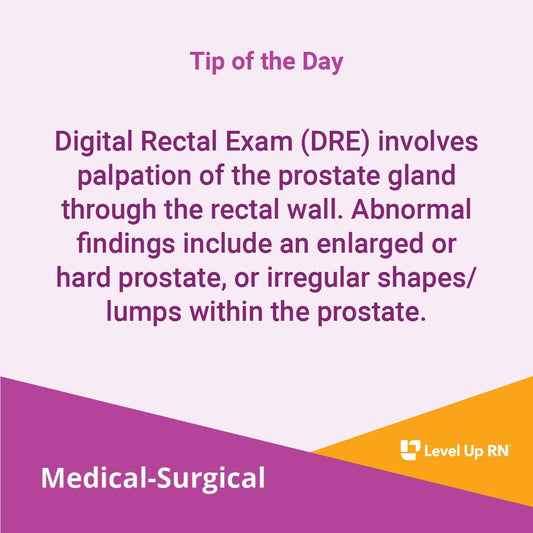
Digital Rectal Exam (DRE)
Digital Rectal Exam (DRE) involves palpation of the prostate gland through the rectal wall. Abnormal findings include an enlarged or hard prostate, or irregular shapes/lumps within the prostate.
Digital Rectal Exam (DRE)
Digital Rectal Exam (DRE) involves palpation of the prostate gland through the rectal wall. Abnormal findings include an enlarged or hard prostate, or irregular shapes/lumps within the prostate.
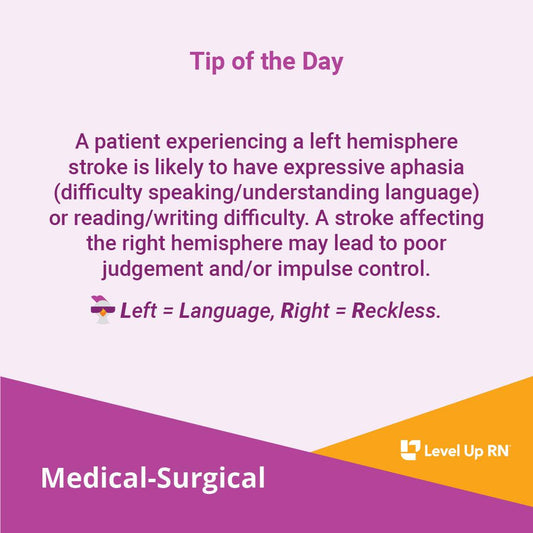
Stroke: Right versus Left Hemisphere
A patient experiencing a left hemisphere stroke is likely to have expressive aphasia (difficulty speaking/understanding language) or reading/writing difficulty. A stroke affecting the right hemisphere may lead to poor judgement...
Stroke: Right versus Left Hemisphere
A patient experiencing a left hemisphere stroke is likely to have expressive aphasia (difficulty speaking/understanding language) or reading/writing difficulty. A stroke affecting the right hemisphere may lead to poor judgement...
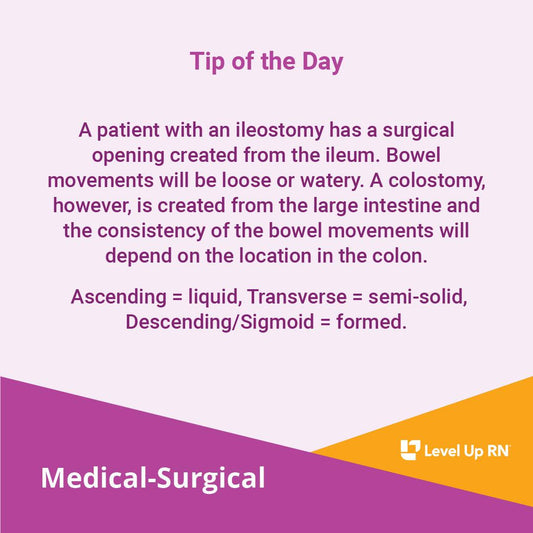
Ileostomoy versus Colostomy
A patient with an ileostomy has a surgical opening created from the ileum. Bowel movements will be loose or watery. A colostomy, however, is created from the large intestine and...
Ileostomoy versus Colostomy
A patient with an ileostomy has a surgical opening created from the ileum. Bowel movements will be loose or watery. A colostomy, however, is created from the large intestine and...
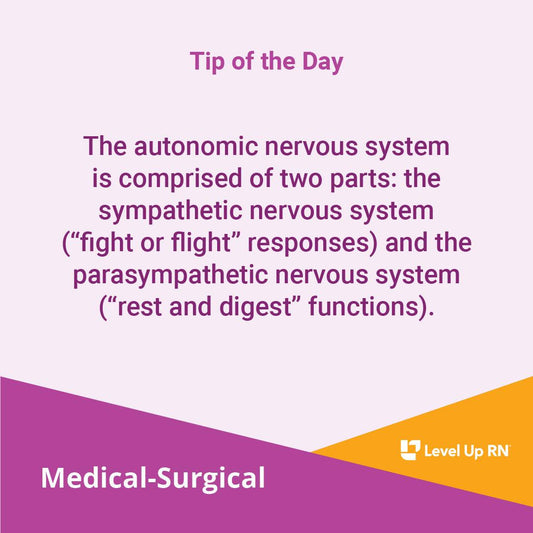
Autonomic Nervous System
The autonomic nervous system is comprised of two parts: the sympathetic nervous system ("fight or flight" responses) and the parasympathetic nervous system ("rest and digest" functions).
Autonomic Nervous System
The autonomic nervous system is comprised of two parts: the sympathetic nervous system ("fight or flight" responses) and the parasympathetic nervous system ("rest and digest" functions).
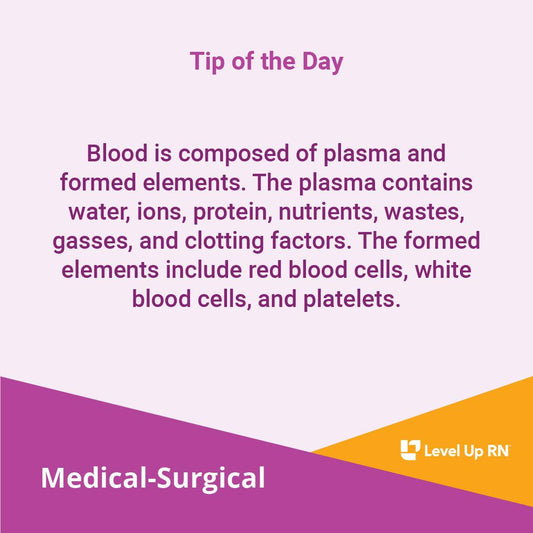
Blood: Components
Blood is composed of plasma and formed elements. The plasma contains water, ions, protein, nutrients, wastes, gasses, and clotting factors. The formed elements include red blood cells, white blood cells,...
Blood: Components
Blood is composed of plasma and formed elements. The plasma contains water, ions, protein, nutrients, wastes, gasses, and clotting factors. The formed elements include red blood cells, white blood cells,...
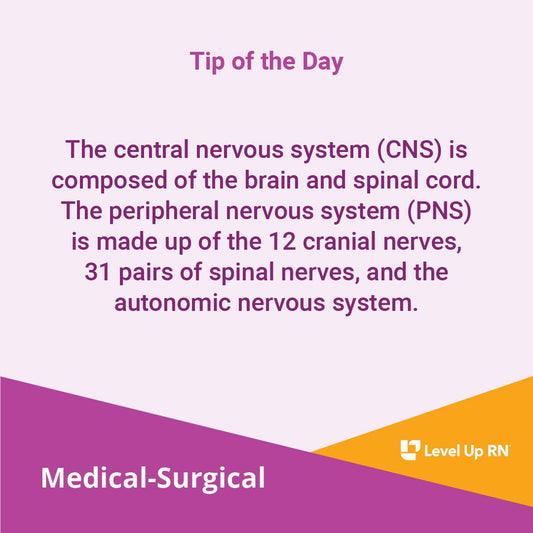
Central Nervous System (CNS)
The central nervous system (CNS) is composed of the brain and spinal cord.
Central Nervous System (CNS)
The central nervous system (CNS) is composed of the brain and spinal cord.
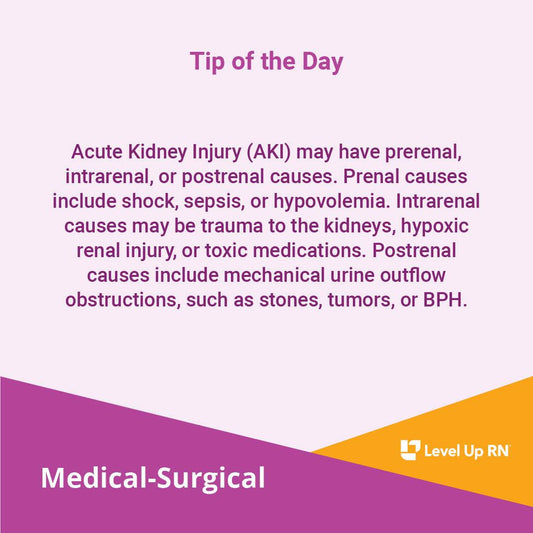
Acute Kidney Injury (AKI): Causes
Acute Kidney Injury (AKI) may have prerenal, intrarenal, or postrenal causes.
Acute Kidney Injury (AKI): Causes
Acute Kidney Injury (AKI) may have prerenal, intrarenal, or postrenal causes.
Filter Articles
Shop
The Ultimate Nursing School Survival Kit - with Flashables and Membership
4.875 / 5.0
(240) 240 total reviews
Regular price $349.95Regular priceUnit price / per$817.95Sale price $349.95SaleVideos by Subject
Tips & More
Exam Information
Subscribe



